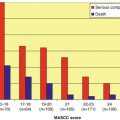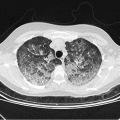Risk factor for infection
Risk category
Low
High
1. Pretransplant
General condition including organ function
Performance status
Good
Poor
Renal failure
No
Yes
Diabetes mellitus
No
Yes
Iron stores [1]
Normal or decreased
Increased
Age
Younger (<40 years)
Older (>65 years)
Smoking [1]
No
Yes
Underlying disease and its treatment
Tumor burden
None
Large
Disease-related immunosuppressiona
Absent
Present
Prior chemotherapy
None or minimal
Extensive
Receipt of purine analogues (fludarabine, cladribine, clofarabine) or monoclonal antibodies (rituximab, alemtuzumab)
No
Yes
Exposure to pathogens
Prior history of infectionb
No
Yes
Colonization with pathogens (bacteria, fungi)
No
Yes
Immunogenetics
No
Yes
2. Pre-engraftment period
Duration of neutropenia [1]
Short (<7 days)
Long (>10 days)
Stem cell source
Peripheral blood
Bone marrow
Quantity of stem cells infusedc
>5 × 106/Kg CD34+ cells
<2 × 106/Kg CD34+ cells
Severity of oral and gastrointestinal mucositis
Absent or mild
Severe
Conditioning regimen
Less intensive
Intensive
Polymorphisms of genes associated with metabolism of chemotherapeutic agents (pharmacogenetics)
Absent
Present
Renal failured
Absent
Present
Exposure to pathogens
Nosocomial exposure to potential pathogens (water and airborne pathogens such as Legionella, Aspergillus spp. and other molds, resistant bacteria, respiratory viruses)
No
Yes
3. Post-engraftment
T cell immune reconstitution
Fast
Delayed
Prior chemotherapy [4]
Minimal
Extensive
CMV serostatus [5]
Negative
Positive
Need for additional chemotherapy to control the underlying diseasee
No
Yes
No
Yes
Exposure to pathogens
Prior history of infectionb
No
Yes
Community-acquired infections, especially respiratory viruses
No
Yes
An important and difficult element of risk assessment in autologous HSCT recipients is to quantify the risk associated with the status of the underlying disease and prior therapies. For example, a patient with MM who undergoes a first autologous HSCT after having received a short course of induction therapy with dexamethasone plus thalidomide and whose disease is under control is at lower risk for certain infections compared with a patient with the same underlying disease, but who is receiving a third or fourth autologous HSCT in the setting of relapse after multiple treatment lines.
4.2 Risk for and Epidemiology of Infection
Immunodeficiency is the key risk factor for infection in autologous HSCT recipients. It is a result of interplay between the underlying disease and its therapy and may involve breakdowns in skin and mucous membrane barriers, qualitative and quantitative defects in various arms of the immune system including innate immunity (neutropenia, neutrophil dysfunction), impaired production of immunoglobulins, and defective cell-mediated immunity (CMI). While autologous HSCT recipients have deficits in various arms of the immune system, the nature of the pathogens causing infection is frequently determined by the immunodeficiency that is predominant at a given time (Tables 4.2 and 4.3).
Table 4.2
Immunodeficiency in autologous hematopoietic cell transplantation
Disruption of skin and mucous membranes | Hypogamma‑globulinemia | T-cell mediated immunodeficiency | Neutropenia and neutrophil dysfunction | |
|---|---|---|---|---|
Immunodeficiency associated with untreated underlying disease | ||||
Acute lymphoid leukemia | + | + | +++ | ++ |
Acute myeloid leukemia | + | + | + | +++ |
Hodgkin’s lymphoma | + | −/+ | +++ | −/+ |
Non-Hodgkin’s lymphoma | + | −/+ | +/+++ | −/+ |
Multiple myeloma | − | +++ | −/+ | + |
Immunodeficiency associated with the conditioning regimen | ||||
Corticosteroids | + | − | +++ | + |
Cytotoxic chemotherapy | −/+++a | +/++ | +/+++a | −/+++a |
Monoclonal antibodies | − | +/++ | +/+++ | +/++ |
Use of catheters | +++ | − | − | − |
Table 4.3
Frequent pathogens causing infection according to immunodeficiency
Disruption of skin and mucous membranes | Hypogamma‑globulinemia | T-cell mediated immunodeficiency | Neutropenia and neutrophil dysfunction | |
|---|---|---|---|---|
Bacteria | ||||
Gram-positive cocci | ||||
Coagulase-negative staphylococci | +++ | − | − | ++ |
Staphylococcus aureus | +++ | − | − | ++ |
Viridans streptococci | +++ | − | − | ++ |
Enterococci | ++ | − | − | ++ |
Streptococcus pneumoniae | − | +++ | − | − |
Gram-positive bacilli | ||||
Bacillus spp. | ++ | − | + | ++ |
Corynebacterium jeikeium | ++ | − | + | ++ |
Listeria monocytogenes | − | − | +++ | − |
Gram-negative bacilli | ||||
Enterobacteriaceaea | ++ | − | − | +++ |
Pseudomonas aeruginosa | ++ | − | − | +++ |
Other nonfermentative bacteriab | ++ | − | − | +++ |
Salmonella spp. | + | + | ++ | + |
Legionella spp. | − | ++ | ++ | − |
Anaerobes | ||||
Clostridium difficile | ++ | − | − | ++ |
Clostridium septicum | ++ | − | − | ++ |
Fungi | ||||
Yeasts | ||||
Candida spp.c, mucosal disease | + | − | +++ | − |
Candida spp.c, invasive disease | ++ | − | − | +++ |
Cryptococcus neoformans a | − | − | +++ | − |
Trichosporon spp. | ++ | − | + | ++ |
Molds (mainly Aspergillus spp.)d | − | − | ++ | +++ |
Other | ||||
Pneumocystis jirovecii | − | − | +++ | − |
Viruses | ||||
Herpes simplex | ++ | − | +++ | ++ |
Varicella-zoster | − | − | +++ | − |
Cytomegalovirus | − | − | +++ | − |
Epstein-Barr virus | − | + | +++ | − |
Respiratory virusese | + | + | ++ | − |
Hepatitis A, B and C | − | + | + | − |
Parvovirus B 19 | − | ++ | ++ | − |
Parasites | ||||
Strongyloides stercoralis | − | − | ++ | − |
Toxoplasma gondii | − | − | ++ | − |
Cryptosporidium parvum | − | + | ++ | − |
Mycobacteria | ||||
Mycobacterium tuberculosis | − | − | +++ | − |
Rapid growing mycobacteria | ++ | − | + | − |
Mycobacterium avium complex | − | − | +++ | − |







